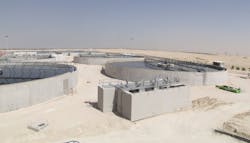Kuwait: Putting UF Through Its Paces
The Sulaibiya wastewater treatment plant in Kuwait is being expanded to meet demand and provide more reused wastewater for agricultural purposes. After testing, submerged hollow fiber ultrafiltration membranes were selected.
By Derek Senior
Many countries face water shortages which are aggravated by accelerated urbanization and economic growth. In response, communities throughout the world are reusing and recycling treated municipal sewage for irrigation and even drinking water, either directly or indirectly, as a means to address water shortages.
To address the needs of industry and its residents, Kuwait has set ambitious water reuse goals. As part of this strategy, Kuwait is investing in a major expansion of its Sulaibiya Wastewater Treatment plant that will increase treatment capacity from 375,000 cubic metres per day (m3/day) to more than 600,000 m3/day. The expansion is expected to be completed in 2018.
Following an extensive one-year pilot test that compared submerged and pressurized ultrafiltration, the plant selected submerged ZeeWeed 1000 hollow fiber ultrafiltration membranes from GE Water & Process Technologies (now Suez Water Technologies & Solutions). ZeeWeed 1000 membranes were chosen for the removal of suspended solids and low energy, chemical and membrane replacement costs.
The immersed ultrafiltration membrane process consists of outside-in, PVDF, hollow-fiber modules immersed directly in the feedwater. The small pore size of the UF membranes ensures that no particulate matter, including Cryptosporidium cysts, Giardia cysts, bacteria, suspended solids or other contaminants of concern, will pass into the treated water stream.
The ZeeWeed 1000 system is operated as a simple semi-batch process where filtration and backwash alternate in sequence. During the filtration process feed water enters at the bottom of a cassette and flows upward through a stack. Permeate is withdrawn through the membranes by applying vacuum to the permeate piping.
Water is removed by permeation is replaced with feedwater to maintain a constant level in the membrane tank. No aeration is used during filtration mode. At the end of each filtration cycle, a backwash is performed with aeration to remove accumulated suspended solids from the membrane surface and maintain permeability.
It should be noted that no chemicals are added during the backwash procedure. Solids are carried out of the system by the tank drain. The tank drain is then performed.
To put the development into perspective, when completed, the Sulaibiya plant will become the world’s largest tertiary wastewater treatment plant with membrane technology.
Project background
In May 2001, a consortium including Mohammed Abdul-mohsin Al-Kharafi and Sons (The Kharafi Group) and SUEZ won a 30-year concession involving three years construction and a water sales contract for 27 years from the Kuwaiti government to recover municipal wastewater from Kuwait City and the surrounding area.
The consortium was established to design, build, own, operate and maintain the 375,000 m3/day wastewater treatment facility at Sulaibiya near Kuwait City. Reclaimed and desalinated water from the Sulaibiya facility is used for non-potable uses that impact the drinking water supply, by blending with brackish water to better exploit existing brackish water distribution facilities.
Commissioned in 2005, the Sulaibiya Wastewater Treatment Plant was one of the first Build-Operate-Transfer infrastructure projects in the Middle East, and was the largest treatment facility of its kind in the world.
The Sulaibiya Plant was designed, built and operated by Utilities Development Company, which is part of the Al Kharafi Group of companies, and the plant is operated and maintained under a subcontract by Kharafi National in partnership with GE on a 30-year concession. The government of Kuwait buys all the reclaimed water produced by the plant for agricultural applications. Furthermore, sludge from the plant is processed to make it suitable for agricultural purposes.
evaluation of Submerged ultrafiltration membranes
During the pilot study, plant operators evaluated the submerged ultrafiltration and pressurized ultrafiltration technology. It was revealed that the submerged design is only 70 percent of the footprint of the pressurized ultrafiltration solution.
The submerged membranes use only a gentle vacuum to suck water through the membranes at a low flux, eliminating the need for feed pumps. The Sulaibiya expansion is projected to save over US$1 million per year, at a low energy cost of 10 cents per kWh.
The submerged ultrafiltration system can go longer between cleanings so chemical costs are also lower. With a longer membrane life, submerged ultrafiltration membrane replacement costs are also lower. A submerged ultrafiltration plant also has less valves (280 vs 400) and piping. Less moving parts typically means lower costs for installation, maintenance and spare parts.
The Sulaibiya project will convert over 600,000 m3/day of municipal effluent wastewater into high quality reclaimed water that will be used for agriculture. This provides an alternate source of water for agriculture instead of using potable water needed for Kuwaiti residents.
The combination of UF and RO technologies provides bacteria, virus and TDS removal, producing high quality water for non-potable water applications. This project provides a benchmark and catalyst for the successful implementation of similar water reuse projects in the Middle East, which are particularly relevant due to the scarcity of water in the area.
Using submerged UF membranes, the Sulaibiya plant is able to realise both capital and energy cost savings. Over the lifetime of the concession, the plant will generate savings of around US$11 billion and will turn water reclamation into an economical and environmentally friendly source of non-potable water use.
Derek Senior is senior product manager, GE Water & Process Technologies. SUEZ, together with Caisse de dépôt et placement du Québec, closed their purchase of GE’s Water & Process Technologies on September 30, 2017. The new business unit is SUEZ Water Technologies & Solutions.
More Water & WasteWater International Archives Issue Articles



